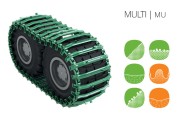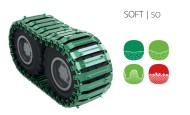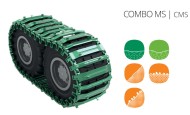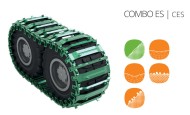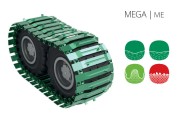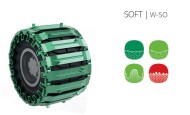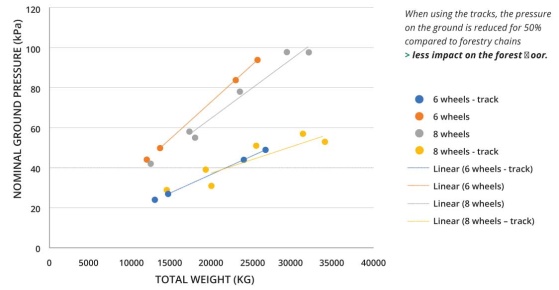
The use of forestry machinery is moving to more complex terrains, where there is no room for compromise. It is necessary to ensure good traction of the machine, minimal impact on the forest oor and minimal fuel consumption.

WHY CHOOSE GREENTRACK?
ENHANCED STABILITY OF THE MACHINE AND GREATER LOADS
Tracks have a much larger contact area with the ground compared to forestry chains.
Advantages:
– Greater contact area with the ground;
– Uniformly distributed force on the surface;
– Constant grip with the surface;
– Increased stability reduces machine tilting;
– The work machine is more stable when driving over uneven surfaces;
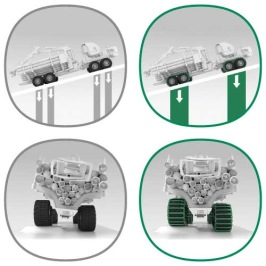
ENHANCED TRACTION AND TRANSMISSION OF FORCE
Regardless on what ground you use the work machine, the greenTrack tracks provide good traction and greater force transmission.
For optimal traction of the tracks with tyres, it is recommended to use tyres with a special channel, into which the track “rests”.
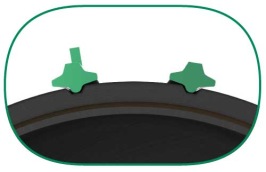
PROLONGED SERVICE LIFE OF THE TYRES
An important part of the machine are the tyres, which represent a substantial cost. With tracks, the lifetime of the tyres are prolonged by up to 60%.
greenTrack tracks have a dual role in the protection of the tyres:
1. The shape of the pro le prevents the wheels from slipping inside the track, while also contributing to the reduced wear of the
tyre tread.
2. Protection of the tread and the sides against sharp ob- jects (stones, rocks), which “cut” into the tyre pro le, thus destroy- ing it.

CARE FOR THE ENVIRONMENT
In a society where caring for the environment is becoming increasingly important,
we cannot ignore the impact forestry machinery has on the forest floor.
LESS IMPACT ON THE FOREST FLOOR
In a society where caring for the environment is becoming increasingly important, we cannot ignore the impact forestry machinery has on the forest floor. To this end, the Biotechnical Faculty of the University of Ljubljana conducted a study in 2010. The graph below shows a part of the study, i.e. reduced nominal ground pressure between 30 and 50% when using tracks instead of forestry chains.
A major impact on the forest oor without the use of tracks The impact of tracks on the forest floor
– a great local burden. – the force is distributed over a larger area.

LOWER FUEL CONSUMPTION
The use of greenTrack tracks increases the contact area, thereby reducing the draft of the machine and the resistance which has to be overcome, while at the same time reducing the fuel consumption.

DEVELOPMENT
We have been gradually developing the greenTRACK tracks for many years before reaching the desired results and o ering the product on the market. We have been in a constant search to nd a compromise between material durability, price and impact on the environment. During the development, we cooperated with experts in the eld of materials and thermal processing, and end users who have the most experience and, most importantly, provided feedback regarding the use of tracks.

MATERIAL SELECTION
We have chosen rolled pro les, not castings, as various researches conducted by experts have shown that only rolled pro les achieve an correspondingly ne structure of the material, ensuring an even and adequate hardness and toughness through the entire pro le.
- We have put a lot of emphasis on the selection of material during the development of the tracks The optimal use of the tracks requires sufficiently hard and tough material, allowing abrasion and impact damage resistance, thus providing a longer lifetime
- Quality welds are essential for the functionality of the product and the lifetime of the track
- A special boron steel includes all the characteristics the material needs for the quality manufacture and use of the tracks
- The tracks are heat-treated until the hardness 42–45 HRC is achieved This ensures abrasion resistance, while at the same time the material is not too hard to break on hard and stony surfaces
LINKS
A vital part of the tracks are the links. Based on analyses and testing, we have determined the optimal diameters of the links, which provide the appropriate transmission of forces and do not increase the weight of the track. We have developed Ø 22, Ø 26 and Ø 30 mm links.
Most commonly integrated are Ø 26 links, which are designed to withstand the hardest tasks and enable
a smooth application. To prolong the lifetime of the track or enable its use in extreme conditions, we recommend the Ø 30 link. With additional material, it ensures the transmission of greater forces and a longer lifetime, while only slightly increasing the weight of the tracks.
If the total weight of the track is more important than the force, i.e. during operation, it is possible to install slightly lighter Ø 22 mm links.
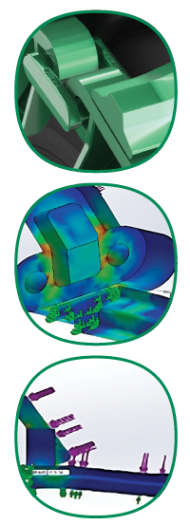
WELDING THE TEETH
In addition to the links, welded teeth are also under a great load and the most exposed. The material is the same as for the pro les, ensuring the same welding conditions. The teeth are serially welded prior to the heat treatment of the track in order to avoid any local softening of the material. The place where the teeth are welded is of a specfic form, providing additional support. The welds are even and continuous, ensuring a long lifetime and usefulness of the teeth. In most cases, one tooth is welded on the crosspiece – alternately on each side.
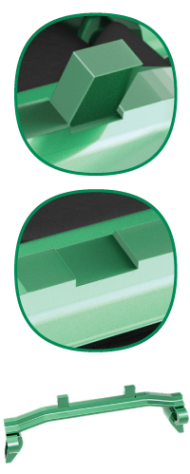
At the customer’s request, we can also weld more teeth, thus increasing the grip.
SIDE ELEMENTS OF THE TRACKS
The function of a sidepart is:
- To restrict the position of the track on the tyre – self-centring;
- The side elements allow the tyres to move within the track at all times – this also enhancing the grip between the tyres and the track which ensures smoother driving;
- Lateral stability of the track – when driving on slopes, the side parts ensure the required support on the tyres;
- Lateral protection of the tyre – protects the tyre against sharp objects and excessive wear
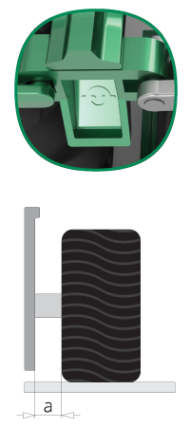
Minimal space between the tyre and the bodywork is a=15 cm


